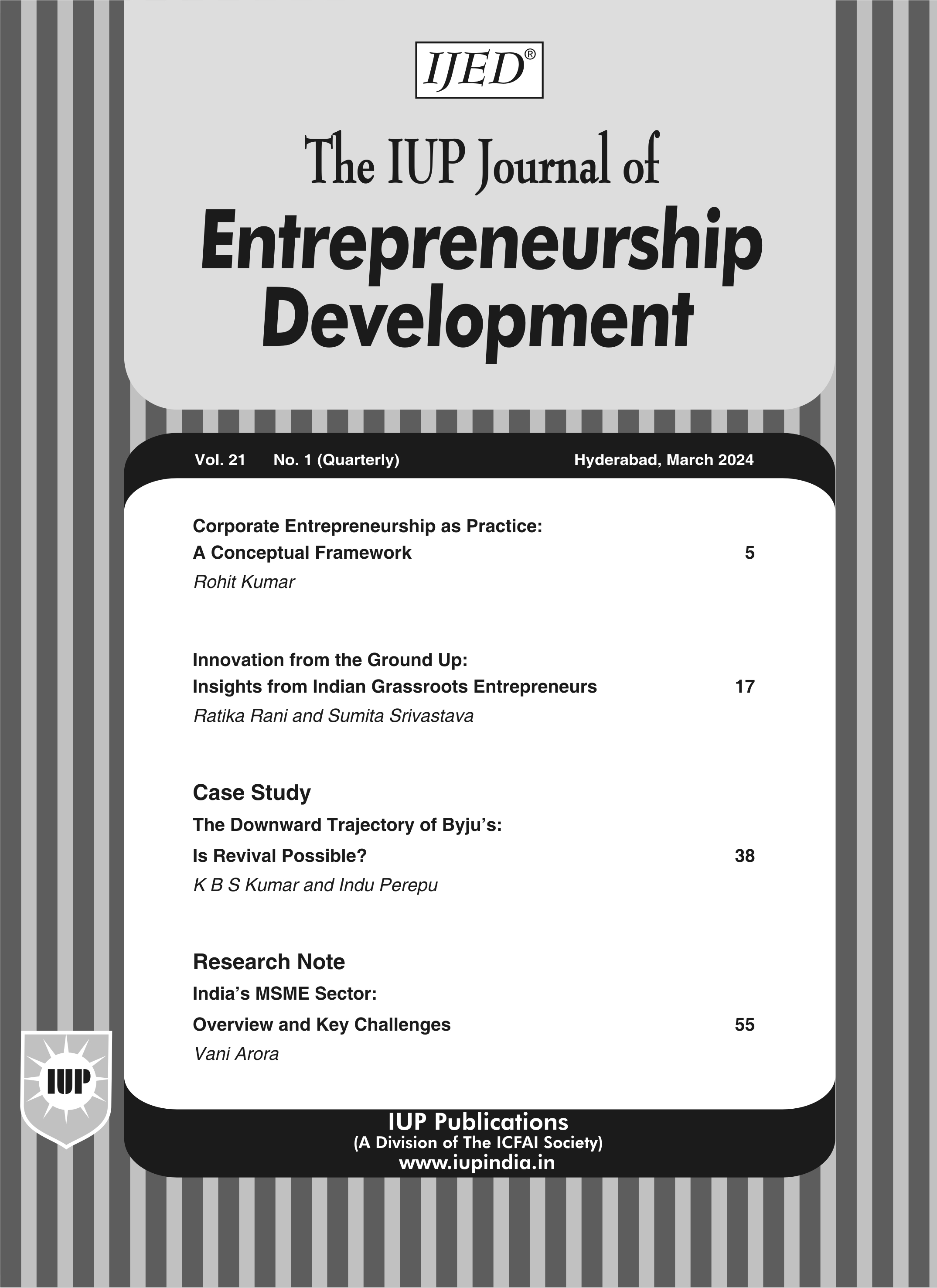
Dec'19
The IUP Journal of Entrepreneurship Development
Archives
Entrepreneurship Development and Poverty Reduction in Nigeria: A Study of Industrial Layout, Emene, Enugu State, Nigeria
Onyi Akachukwu Joseph
Lecturer II, Department of Industrial Relations and Personnel Management, College of Management Sciences,
Michael Okpara University of Agriculture, Umudike, Abia State, Nigeria; and is the corresponding author.
E-mail: johaka4me@yahoo.co.uk
Ikechukwu Dialoke
Senior Lecturer, Department of Industrial Relations and Personnel Management, College of Management Sciences,
Michael Okpara University of Agriculture, Umudike, Abia State, Nigeria. E-mail: drikechukwudialoke@yahoo.com
Edeh Friday Ogbu
Lecturer II, Department of Business Management, Faculty of Management and Social Sciences, Alex
Ekwueme Federal University, Ndufu-Alike, Ebonyi State, Nigeria. E-mail: edeh.ogbu@gmail.com
This study evaluates the effect of entrepreneurship development on poverty reduction in Nigeria using data from the industrial layout, Emene in Enugu State. Survey research method was adopted for making qualitative and quantitative evaluation by collecting relevant and substantive data. Primary and secondary data were used. A questionnaire was designed to collect necessary and relevant data from 396 respondents. The hypotheses were tested using regression analysis. The results showed that all the independent variables (skill acquisition, youth requisite training and creativity and innovations) had positive significant effect on the dependent variable (poverty reduction). The study recommends that all the levels of government, academic institutions, donor agencies and private organizations should urgently support entrepreneurship development as it is a good strategy for reducing poverty in Nigeria and other countries of the world.
Introduction
One of the major challenges faced by developing countries like Nigeria is the provision of
adequate employment for its citizen. Entrepreneurship is considered as the bedrock for
sustainable economic development and poverty alleviation in developing countries, like
Nigeria. An entrepreneur is a person, who embarks on the path of innovation as well as
finances the business in an effort to obtain economic value for innovations. In other words,
it is the ability to perceive and undertake business opportunities, utilizing scarce resources.
Hisrich and Peters (2002) described entrepreneur as a person who takes the necessary steps
to develop something new that has value and back it up with the necessary financial initiative,
and takes the risks involved that usually results in financial reward and personal satisfaction.
Poverty arises when people lack, i.e., cannot afford the three essential requirements of
living-food, clothing and shelter. According to World Bank (2018), poverty is the economic
condition in which people lack sufficient earnings to obtain certain minimal levels of health
services, food, housing, clothing and education which are necessities for living. Poverty is
now the world's greatest challenge, and the major developmental objectives are achievement
of equality in the distribution of income and reduction of poverty. There are two types of
poverty: (1) people living on less than US$1.90 per day as extreme poverty; and (2) people
living on less than US$3.10 per day as moderate poverty. Poverty reduction is the top priority
of the United Nations (United Nations, 2018).
Entrepreneurship seems to be the backbone of every vibrant and resilient economy. The
importance of entrepreneurship in enhancing Human Capital Development (HCD) in terms of
poverty alleviation, employment generation, wealth creation and economic synergy has given
entrepreneurship global prominence. Thus, the need for the pursuit of poverty reduction
through entrepreneurship is highly essential for growth and structural alteration of an
economy and realization of economic development.
During the fourth quarter of 2015, out of an economically active population (15-65 years)
of 104.3 million, the labor force was 75.9 million, youth population was 36.38 million (48%
of the total work force) and about 20.7 million (49.6% of work force) were either unemployed
or underemployed. These records highlighted the need for proficient entrepreneurial
development in Nigeria which is vital for socioeconomic growth, poverty reduction and
sustainable development (NBS, 2016).
Deficient capacity building normally results in prevalent poverty, corruption, insufficient
resources and ineffective human capital supplies (Roy, 2010). Nigeria was experiencing
increasing rate of poverty both at the state and national level, accompanied by high
unemployment rate, high income disparity, low quality human capital, and high percentage
of population migrating out of the country NBS (2014). World Bank (2018) posits that many
developing countries in Africa have now realized that entrepreneurship development is the
only way of attaining industrialization and consequently are making conscious efforts for
developing native entrepreneurs as an alternative measure for poverty reduction and wealth
creation.
Despite the fact that entrepreneurial development has brought far-reaching transformations
in the economy, it is still neglected and therefore restricted from developing to its full
potential. A small body of literature is available on the effect of entrepreneurship development
on poverty reduction. Hence, the present study is an attempt to fill this gap. This study focuses
on entrepreneurship and poverty reduction in Nigeria. It considers the entrepreneurship
activities conducted in the industrial layout, Emene, Enugu State in Nigeria.
Literature Review
Concept of Entrepreneurship and Entrepreneurial Development
CBN (2015) defined entrepreneur in various ways: the originator of a profit-making or
economic venture which is instituted for the purpose of providing goods and services that satisfy the needs of the people. It entails an individual who undertakes innovations, uses his/
her acumen in an effort to transform innovations into economic goods that results in profit
making. Entrepreneur can be viewed generally as a person who wields some personality or
traits to start up a business venture with the purpose of making profit. It involves the ability
of an individual to identify profitable opportunities and have the understanding, expertise and
attitude to act on them. Entrepreneurs control the manufacturing industries in Nigeria and
account for about 70% of manufacturing employees and 10-15% of industrial production
(CBN, 2015).
In his contribution, Paul (2014) sees entrepreneurship as the effective manipulation of
human intelligence as demonstrated in creative performance. It is the enthusiasm and the
capability of an individual to search for latest business opportunity, set up the business based
on feasibility study and manage it successfully either for income making or societal benefit.
It also includes creating innovation and promoting new sets of attitudes and culture for the
attainment of upcoming challenges (Dialoke et al., 2017).
Entrepreneurship is an important element in the dynamics of all economies and it is
regarded as the driving force in economic growth and job creation (Sunter, 2005; and
Ogbodo, 2009). It is actually concerned with the recognition of gaps and commercial
opportunities in individual's direct surroundings and bringing together the necessary
resources in an innovative way to fill these gaps and in the process gaining personal rewards
(which may or may not be for profit motive). Entrepreneurship can be viewed as the process
of gathering human and non-human resources to create and build an independent enterprise.
This process entails skill acquisition, creativity, risk-taking and innovation, among others
(Dialoke et al., 2017).
Human Capital Development
Entrepreneurship is one of the ways by which HCD can be enhanced in a country. Human
capital is the term economists often use for education, health and other human capacities that
can increase productivity, when improved. It entails human beings who have acquired skills,
knowledge and attitudes which are needed to achieve organizational productivity. This can
be achieved through education and training. In other words, it refers to the abilities and skills
of human resources of a country, while HCD refers to the process of acquiring and increasing
the number of persons who have the skills, education and experience that are critical for the
economic growth and development of an economy (Okojie, 2005). HCD, therefore, focuses
on all activities directed towards producing people with appropriate skills, knowledge,
attitude, motivation and job-related experience which is required for organizational
productivity and improvement.
An early advocate of HCD, Adam Smith, viewed it as an acquired and useful capability
of every individual of the populace or members of the society. Todaro and Smith (2009)
viewed human capital as the productive investment embodied in individuals. These include
skills, abilities and ideas resulting from expenditure on education, on-the-job training
programs and healthcare.
Entrepreneurship and Creativity and Innovation
Entrepreneurship development is a process embarked on by the government to reduce the
level of poverty in the economy. It entails creating innovation and promoting new sets of
attitudes and culture for the attainment of future challenges (Ibitoye et al., 2015). Creativity
is simply a matter of being aware that things can be done in many different ways. While
necessity is said to be the mother of invention, creativity is the father of invention. Some
people are aware or at least confident enough to have fewer inhabitants and can easily put
their creativity into work.
Innovation, on the other hand, is the ability to apply new ideas that enable one to
approach activities differently in order to achieve better results. It is all about improving on
the existing way of doing things through personal inventiveness and thoughts. An innovative
person is able to change things around or formulate new ways of doing things in order to
contain whatever new situation that may arise. Information on different issues and fields
therefore serve as inputs. Thus, successful entrepreneurs place great value on information and
constantly engage themselves in research. Innovation in the business context is generally
regarded as the product or application of creativity. It can thus be seen as the specific
instrument of entrepreneurship (Okafor, 2014).
The importance of entrepreneurship in enhancing HCD in terms of poverty alleviation,
employment generation, wealth creation and economic strength has given entrepreneurship
global acknowledgment. The fundamental drive of this investment in human capital goes on
to cause improvement in productivity and performance, which leads to more output of goods
and services in an economy. Many scholars have concluded that the disparity in the echelon
of socioeconomic development between countries is not only due to their natural resources
and physical capital but the quality of human capital (Dauda, 2010).
Entrepreneurship and Skill Acquisition
Skill acquisition is equivalent to entrepreneurship training and education or HCD. McClure
(2005) depicts that skill acquisition is the ability to execute a job either mentally or
physically, which engage building up a series of process and actions into a consolidated
progression. He advocated a model of skill acquisition for students through formal instruction
and practicing.
According to Fakomogbon and Adegbija (2011), skill is the ability developed in the
process of training and experience. Skill acquisition is a process where the youth, through
learning of necessary skills that enable them to be self-reliant, become useful to the society
by embarking on profitable entrepreneurship venture. Of all factors of production, only human
beings are capable of learning, adapting or changing, being innovative and creative. The
human factor affects production immensely. Entrepreneurship equips the youths to embrace
entrepreneurial culture and supports the government entrepreneurship programs necessary for
their empowerment. It inculcates six empowerment elements-psychological, community,
organizational, economic, social and cultural-in the youth.
Concept of Poverty
Poverty has been defined in various ways and contexts. Poverty implies lack of basic things,
such as food, clothing, shelter and access to potable water, all of which decide the value of
life. It may also include access to opportunities such as education and employment which aid
the escape from poverty and/or allow one to enjoy the respect of fellow citizens. Poverty, in
general, entails a state in which an individual or household is unable to meet the basic needs
of life considered as the minimum requirements to sustain livelihood in the given society. It
is a deplorable dispossession of individual of basic requirements of life. It can be
physiological or social deprivation. Physiological deprivation entails the non-fulfilment of
basic material or biological needs, including inadequate nutrition, health, education, and
shelter. Social deprivation widens the concepts of deprivation to include risk vulnerability,
lack of autonomy, powerlessness and lack of self-respect (CBN, 2015).
Absolute poverty is a situation where an individual is constrained with limited financial
resources and he is unable to meet his/her basic needs of life such as food, clothes, shelter
and health. A World Bank (2018) report indicated that individuals, families or groups are
considered to be absolute poverty-oriented when they lack the resources, particularly real
income, to obtain the fixed minimum standard of living by a given society.
About 2.8 billion persons of the world's population live on less than $2 a day, and 1.4
billion on less than $1 a day (World Bank, 2009). Poverty is a major limitation of economic
development and the absence of economic opportunity is seen to increase the poverty level of
an individual or household. This lack of opportunities is reinforced by inequality. Analysts have
argued that problems of poverty and inequality need appropriate policies that aim at bridging
gaps and ensuring that the poor in a given population can benefit from it.
Poverty Reduction
According to World Bank's report on the level of poverty in Nigeria in 1999, the Human
Resource Index of Nigeria was 0.47 and almost 70% of the population was living below
poverty line (World Bank, 2013). According to World Bank (2014), two-thirds of 170 million
Nigerians struggle in poverty in Africa's biggest oil producer. Despite per capita income of
more than $2,700 and annual GDP growth of 7%, 70% of the people live on less than $1.25
a day. In the north, 72% live in poverty as compared to 27% in the south and 35% in the
Niger-Delta. According to the NBS (2014), Nigeria's unemployment rate increased to 23.9%
in 2011 as compared to 21.1% in 2010 and 19.7% in 2009.
Human Development Index in 2011 puts Nigeria at 156th position among 177 countries
as compared to the 151st position in 2002 (World Bank, 2015). Nigeria's Human Poverty Index
for 2009 was only 36.2%, placing Nigeria at the 114th position and among the seven poorest
nations in the world, while the ratio of the richest 10% to the poorest 10% was 16.3 with Gini
index from 42.9 in 2004 to 44.7 in 2010 (UNDP, 2013; and NBS, 2014). Yet the country ranks
at 6th and 7th positions among oil producing and exporting countries and ranks 10th as the most
populous country in the world with a real GDP growth rate of 7 in 2009 which increased to
8 in 2010, which however dropped to 6.3 in 2013. Reducing poverty is important for sustainable development because in most developing countries, the likelihood of being poor
and the sternness of poverty is high (World Bank, 2015).
Youth Empowerment
Youth empowerment refers to all genuine efforts and strategies aimed at providing the youth
with suitable skills, developmental know-how and all positive atmosphere towards enhancing
their survival and achieving sustainable livelihood that will affect the present and future
growth and development of the nation (Obizue, 2016). UNESCO (2015) identifies four major
thrusts to begin the work of youth empowerment as a tool for sustainable development. They
are: improving youth's access to quality entrepreneurship education, reorienting existing
education, developing public awareness and motivation for entrepreneurship ventures and
ensuring efficient training by adequate planning and funding of entrepreneurship education.
The Nigeria Youth Policy is the document that stipulates broad guidelines for the
implementation of empowerment initiatives and projects of youth. The overall goal of the
policy is to provide rights and protect the health, social, economic and political wellbeing
of all young men and women in order to enhance their participation in the overall
development process and improve their quality of life.
Youth empowerment organizations and scheme in Nigeria include:
- Youth with innovation in Nigeria..
- Subsidy reinvestment and empowerment program (SURE-P)..
- Youth Initiative for Sustainable Agriculture in Nigeria (YISA)..
- Graduate Internship Scheme (GIS) (Journal of Education of Practice, Online, 2017).
Causes of Poverty in Developing Countries (Nigeria)
Poverty in developing countries like Nigeria has impeded their economic growth and
development. Some of the causes of poverty in developing countries include:
- The impact of Boko Haram insurgency in North East.
- Inadequate access to employment opportunities of majority of the populace.
- Inadequate access to the means of fostering rural development in poor regions.
- Inadequate access to markets for the goods and services produced in rural areas.
- Inadequate access to assets such as land and capital by the populace.
- Inadequate access to education, health, sanitation and water services.
- Inadequate access to assistance for victims of Boko Haram drought, flood, pests and war.
- Inadequate involvement of the poor in the design of development programs (Dialoke et al., 2017).
Theoretical Framework
The Schumpeter Effect
Schumpeter (1934) views entrepreneurship training as responsible for creative destruction.
Education acts as a thrust for creating new ideas, improved techniques, new technologies and
new products. This theory provides logical explanation that entrepreneurship and
unemployment are negatively or inversely related, i.e., increase in entrepreneurship activities
in the economy quenches and sustainably reduces unemployment situation. The process of
entrepreneurship leading to gainful employment is termed 'Schumpeter effect'.
The implication of the above theory is that when people are provided qualitative
entrepreneurship education with hands-on training, they tend to establish their own business
later. The theory argues that entrepreneurship training enhances the cognitive state of an
entrepreneur and in turn improves entrepreneurship. In other words, entrepreneurship activities
lead to increase in setting up of more businesses and hence reduction in unemployment and
poverty, thus leading to increase in productivity and wealth, economy growth and
development. The long-term effect is increase in efficiency of human capital by increasing
the level of their cognitive skills, and therefore any investment in entrepreneurship venture
will increase the stock of human capabilities.
Capitalist Entrepreneurial Theory
The first theory that links entrepreneurship and poverty reduction is the theory of capitalist
entrepreneurial. This theory focuses on basic exploitation of the poor by means of low wages
and poor condition of services which allow for possible rise in savings among the
entrepreneurial class. This theory was extracted from Max Weber's Sociological Theory. The
entrepreneur becomes a role performer in conformity with the role of expectations based on
religious beliefs, taboos and customs. Capitalism thrives under the protestant work ethic that
harps on these values. This is the class struggle between the owners of the means of production
and the workers (bourgeois and proletariate). The ensuing inequality could lead to vast
poverty among the lower income earner, who are the majority in the society.
Empirical Review
Emerole et al. (2016), in their study using a sample size of 260, concluded that requisite
training and knowledge, youth skill acquisition and entrepreneurship drive are the variables
that have positive correlation with HCD and recommended that all levels of government,
academic institutions, donor agencies and private organizations should urgently support
entrepreneurship education as it is strategic for HCD in Nigeria.
Kareem (2015) found that there is a positive significant relationship between
entrepreneurship and poverty alleviation. Dialoke et al. (2017), in their study, with a sample
size of 248, concluded that there is a positive correlation between entrepreneurship and
poverty reduction. They recommended that entrepreneurship training and development
should be instituted by local government among others. Ibitoye et al. (2015) in their study,
found that there exists a positive and significant relationship between entrepreneurship and
poverty.
Objective
The objective of this paper is to examine the effects of effective entrepreneurship development
on poverty reduction in Nigeria. The specific objectives are to:
- Evaluate the impact of skill acquisition on youth empowerment in industrial layout, Emene, Enugu, Nigeria.
- Ascertain the effect of requisite training on job creation in industrial layout, Emene, Enugu, Nigeria.
- Determine the influence of creativity and innovations on wealth creation in industrial layout, Emene, Enugu, Nigeria. Based on the objectives, three research questions were formulated:
- How does skill acquisition affect youth empowerment in industrial layout, Emene, Enugu, Nigeria?
- What is the impact of requisite training on job creation in industrial layout, Emene, Enugu, Nigeria?
- How does creativity and innovation affect wealth creation in industrial layout, Emene, Enugu, Nigeria? Based on the research questions, the following hypotheses were formulated.
H01: Skill acquisition has no significant effect on youth empowerment in industrial layout, Emene, Enugu, Nigeria.
H02: Youth requisite training has no significant influence on job creation in industrial layout, Emene, Enugu State.
H03: Creativity and innovation has no significant influence on wealth creation in industrial layout, Emene, Enugu State.
Data and Methodology
Research Design
The study adopted survey research design. This allowed for representative sampling and
correlation analysis in predicting behavior (Borden and Abbott, 2002). The descriptive
technique was adopted in the analysis.
The study uses both sources of data-primary and secondary. Primary source of data was a selfdesigned,
closed-ended, pretested questionnaire consisting of 20 items (see Appendix). Secondary
data was gotten from published books and reviewed journals including electronic works.
The study was conducted in the industrial layout, Emene, Enugu, one of the southeastern
states of Nigeria. The choice of the area was based on a long history of entrepreneurial
activities. The actual population of this study is the registered and non-registered enterprises
in the industrial layout. The population of study is 2,892, obtained from the Enugu State
Ministry of Commerce and Industry (SMEs Unit) (ENSG, 2019).
Sample Size
Using the modified Taro Yamane formula for calculating sample size.
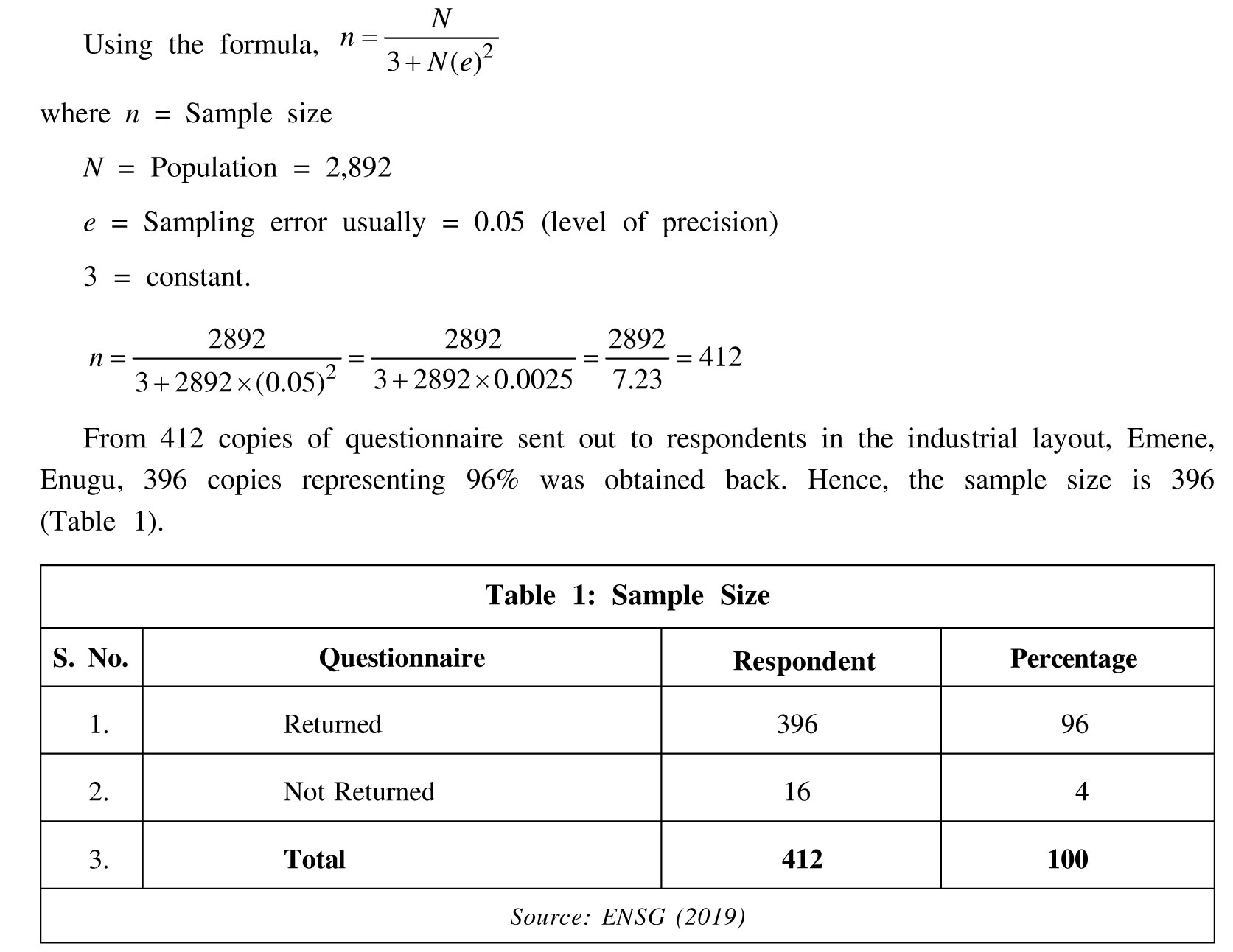
Method of Data Analysis
The research instrument used for eliciting information is a Likert-type questionnaire titled
"Entrepreneurship and Poverty Reduction in Nigeria Questionnaire" (EAPRNQ). 5-point rating
scale instruments were used with the following response options: Strongly Agree (SA) - 5, Agree
(A) - 4, Undecided (UD) - 3, Disagree (D) - 2; and Strongly Disagree (SD) - 1. The
questionnaires were subjected to face validation by three experts from Department of
Entrepreneurial Studies, Michael Okpara University of Agriculture, Umudike. The corrected
version of the instrument guided the structuring of the questionnaire.
The instrument was subjected to reliability test to ascertain the internal consistency of the
instrument. To ascertain the reliability of the instrument, a pilot study was carried out on a
sample of 20 entrepreneurs in the industrial layout. After a period of 10 days, the same
instruments were re-administered to the same respondents. The results were collated and
analyzed using Cronbach's alpha (?) method. The reliability coefficient of 0.775 was obtained
indicating that the instrument was reliable for the study. Descriptive statistics was employed
in the analysis of the questionnaire, while simple regression analysis was employed in testing
the hypotheses.
Decision Rule: Reject H0 = If F-calculated is greater than F-critical and if p-value is less than
0.05 level of significance. The relationship between the variables is positive if the correlation
coefficient is positive, while it is negative if the correlation coefficient is negative. The
relationship is significant if the probability value (p-value) is less than 0.05 and not
significant if the p-value is more than 0.05.
Independent Variables:
Entrepreneurship Development
Decision Rule: Reject H0 = If F-calculated is greater than F-critical and if p-value is less than
0.05 level of significance. The relationship between the variables is positive if the correlation
coefficient is positive, while it is negative if the correlation coefficient is negative. The
relationship is significant if the probability value (p-value) is less than 0.05 and not
significant if the p-value is more than 0.05.
Independent Variables:
Entrepreneurship Development
- Skill acquisition
- Youth Requisite Training
- Creativity and Innovations Dependent Variable:
- Youth empowerment
- Job creation
- Wealth creation
Poverty Development
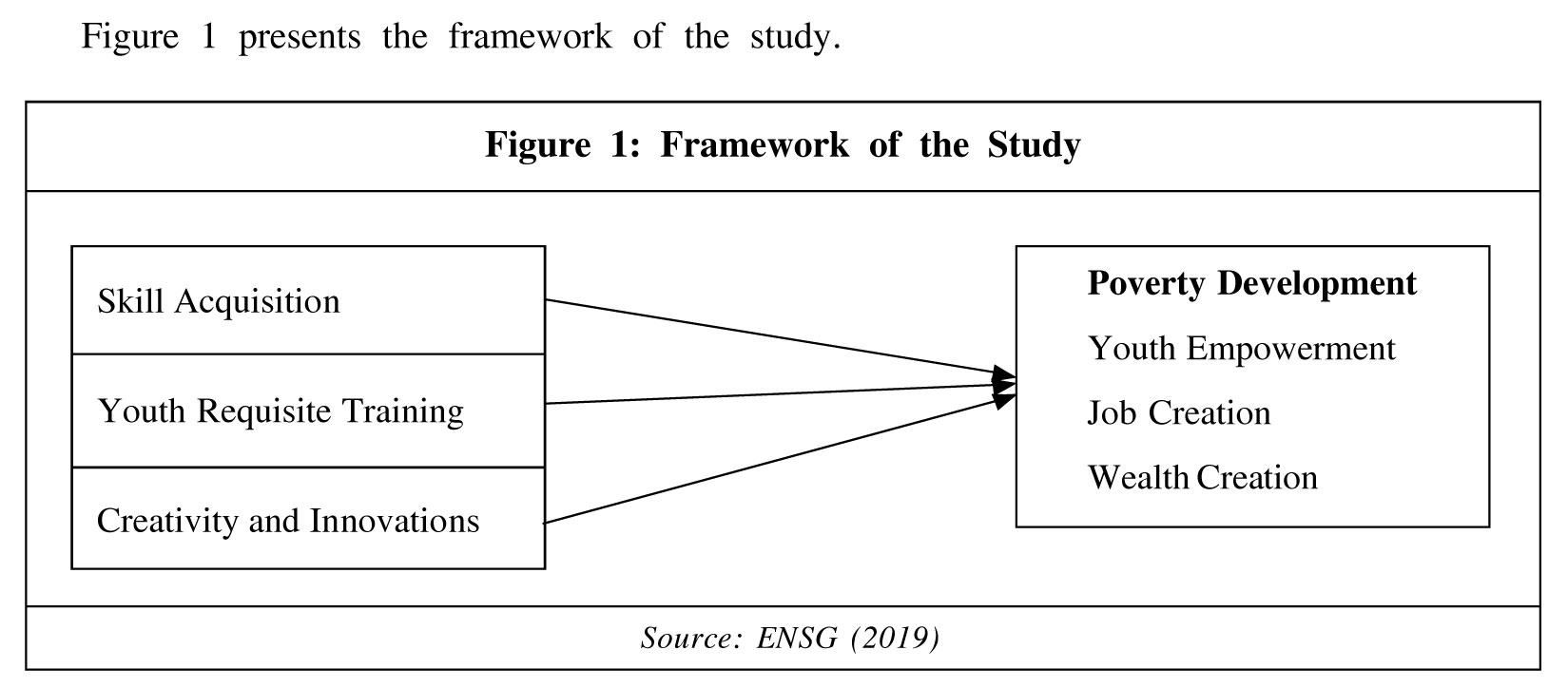
Results and Discussion
Demographic Characteristics of the Respondents
It is observed from Table 2 that 297 (70%) of respondents were male, while 99 (30%) were
female. 99 (25%) respondents were aged between 16-20 years, 99 (25%) were aged between
21-29 years, 198 (50%) respondents were aged 30 years and above. Hence, most of the
respondents mainly belonged to productive age. Further, 198 (50%) respondents were single
and 198 (50%) were married. 99 (25%) of respondents had enjoyed entrepreneurship for
1-5 years, 99 (25%) of the respondents had enjoyed entrepreneurship for 6-10 years, while 198
(50%) had enjoyed it for 10 years and above.
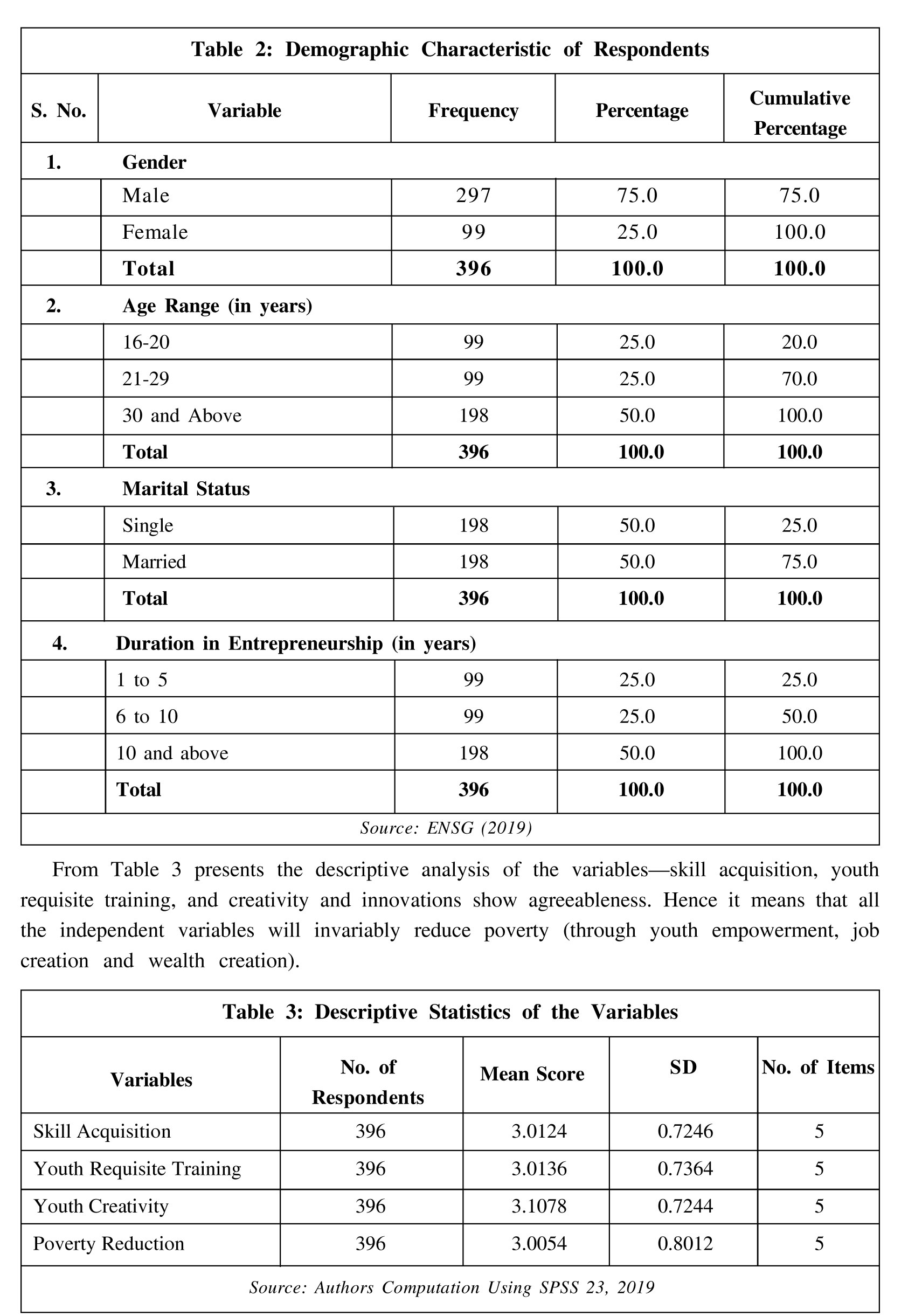
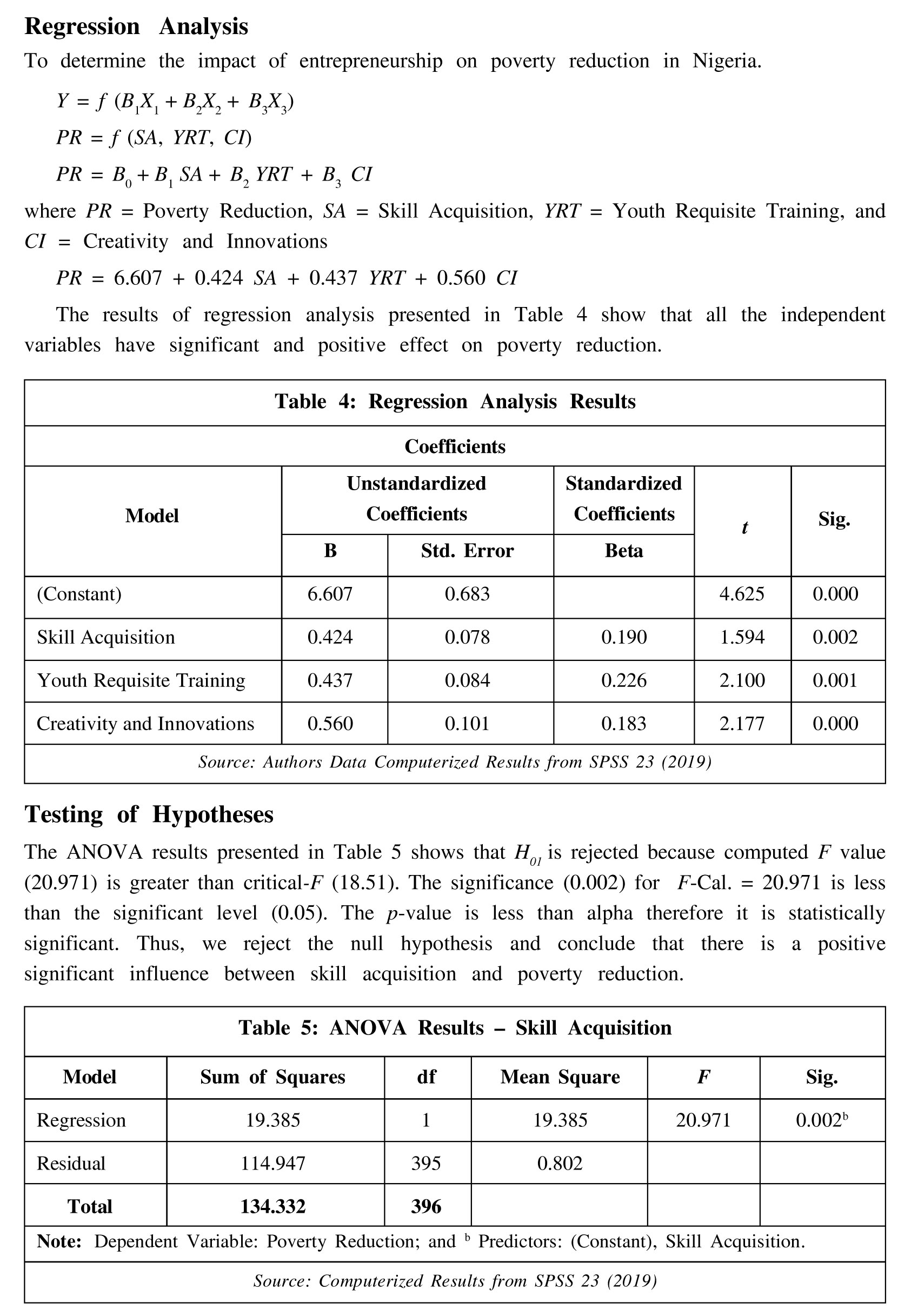
The ANOVA results presented in Table 6 show that H02 is rejected because computed F-value (21.601) is greater than critical-F (18.51). The significance (0.001) for F-Cal. = 21.601 is less than the significant level (0.05). The p-value is less than alpha, therefore, it is statistically significant. Thus, we reject the null hypothesis and conclude that there is a positive significant effect between youth requisite training and poverty reduction.
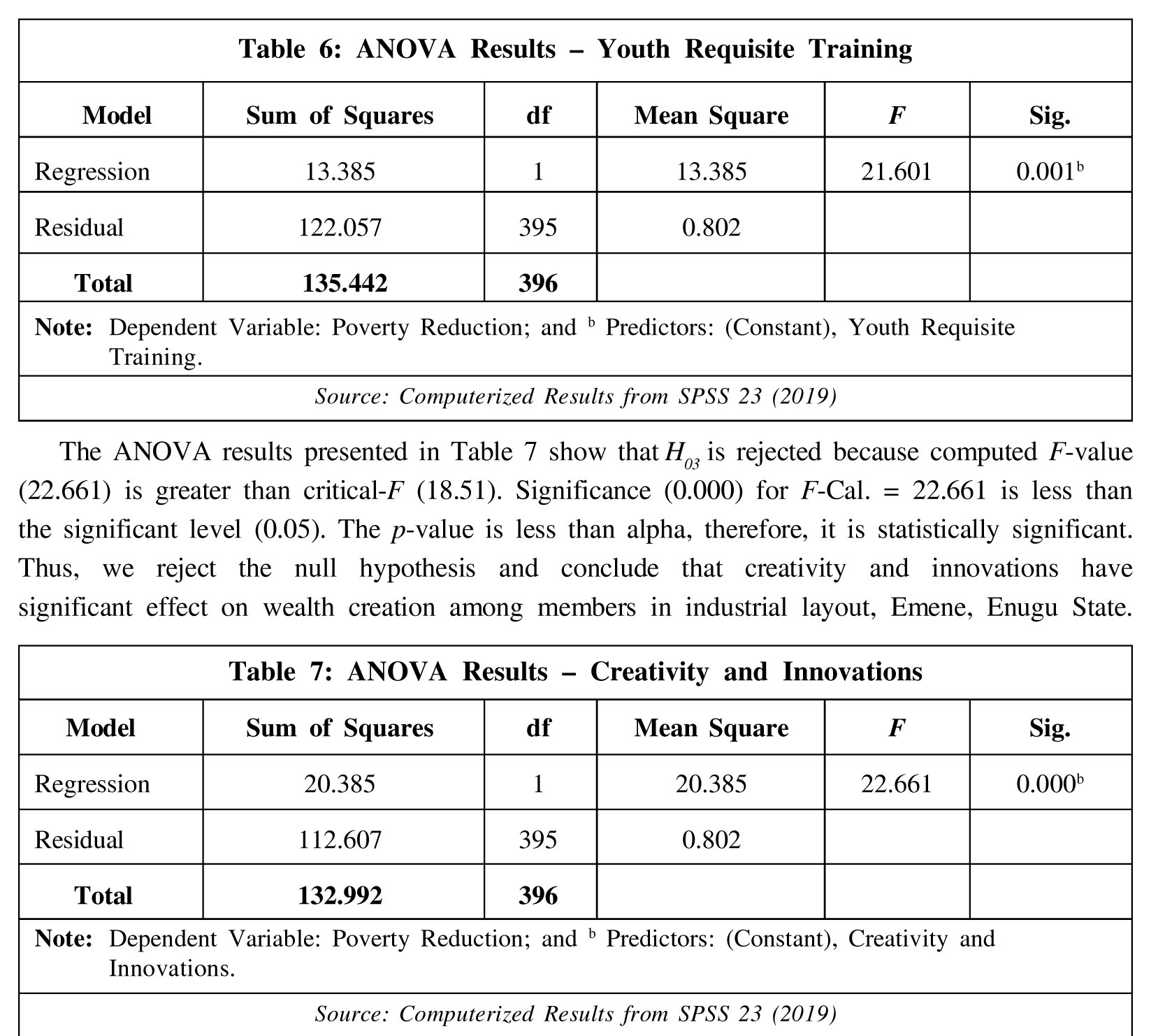
This study examined the impact of entrepreneurship on poverty reduction in Nigeria using the industrial layout, Emene, Enugu State in Nigeria. Data was collected through self-designed questionnaire having 20 items from a sample of 396 respondents. Correlation and regression analysis with 5% significance level was used to analyze data and test the hypotheses respectively. All the three variables tested-skill acquisition, youth requisite training, and creativity and innovations-were shown to have significant positive effect on poverty reduction (youth empowerment, job creation and wealth creation).
Based on the objectives and the findings of the research, the study concludes that there is a positive significant influence between entrepreneurship development (skill acquisition, youth training, and creativity and innovations) and poverty reduction (youth empowerment, job creation and wealth creation) in industrial layout, Emene, Enugu State, Nigeria. This suggests that without effective entrepreneurship many people could be put at risk of being unemployed, hence poverty will reign. However, there are problems facing the effective implementation of entrepreneurship programs in Nigeria such as corruption, inadequate funding of entrepreneurship, etc.
Recommendations: In line with the findings of the study, the following recommendations are made:
- All the levels of the government should establish entrepreneurship training centers in the vicinity. This approach would help to instill entrepreneurship culture and promote human empowerment and development through entrepreneurial skill acquisition and training, thus reducing poverty in the society.
- Government and private individuals should encourage entrepreneurial programs by massive awareness and sensitizing the populace, especially the youth, about the need to instill entrepreneurship culture as a way to overcome poverty in the society. This, no doubt, will encourage skill acquisition among youth and imbibe entrepreneurial traits in them.
- The government should provide more infrastructure for entrepreneurial development and provide credit schemes, especially to the young artisans and youth in the society to encourage entrepreneurial development. This will encourage more creativity and innovation among the youth and thus lead to wealth creation in the society.
References
- Bordens S K and Abbott B B (2002), Research Design and Methods: A Process Approach 5th Edition, McGraw-Hill, New York, available at www.hha.dk/man/cmsdocs/WP/2010/ wp2010_03.pd
- CBN (Central Bank of Nigeria) (2015), "Micro Finance Policy, Regulatory and Supervisory Framework for Nigeria", A Publication of Central Bank of Nigeria, Abuja, Nigeria, available at http//www.cenbank.org/inst-mfasp
- Dauda R O (2010), "Role of Human Capital in Economic Development: An Empirical Study of Nigerian Case", Oxford Business and Economics Conference Program, Oxford.
- Dialoke I, Onyi A J and Edeh O F (2017), "Entrepreneurship and Poverty Reduction in Nigeria: Empirical Analysis of Industrial Layout Coal Camp, Enugu-State", Nigeria Journal of Educational Policy and Entrepreneurial Research, Vol. 4, No. 3, pp. 115-130.
- Emerole O B, Onyi A J and Obiekwe C J (2016), "Entrepreneurship Education and Human Capital Development in Nigeria: Empirical Analysis of Michael Okpara University of Agriculture", Umudike International Advanced Journal of Teaching and Learning, Vol. 2, No. 9, pp. 130-148.
- ENSG (Enugu State Government) (2019), Annual Report, Printing Press, Enugu.
- Fakomogbon M A and Adegbija M V (2011), "Higher Education and Current Issues on Skills Development in Nigeria", Journal of Research in Education, Vol. 1, No. 1, pp. 195-199.
- Hisrich R D and Peters M P (2002), Entrepreneurship, 5th Edition, McGraw-Hill, New York.
- Ibitoye O, Atoyebi K O and Sufian J B (2015), "Entrepreneurship and Poverty Reduction in Nigeria: An Empirical Analysis", Journal of Business and Management (IOSR-JBM), Vol. 17, No. 3, Ver. III, pp. 16-19, available at www.iosrjournals.org
- Kareem R O (2015), "Impact of Entrepreneurship on Poverty Alleviation", Journal of Business Administration and Education, Vol. 7, No. 1, pp. 1-16.
- McClure C (2005), "Drefus Model of Skill Acquisition", University of Arizona, available at azmecmed.arizonaedu/Dretus%20model20of%20skills%Acquisition,ppt. Retrieved on October 28, 2013.
- NBS (National Bureau of Statistics) (2014), Annual Abstract of Statistics, NBS Press, Abuja.
- NBS (National Bureau of Statistics) (2016), Annual Abstract of Statistics, NBS Press, Abuja.
- Obizue M N (2016), "Lecturers' Perception on the Viability of Entrepreneurship Education for the Attainment of Sustainable Development Goals in Nigeria", African Journal of Higher Education Studies and Development (AJHESD), Vol. 2, No. 2, pp. 32-44.
- Ogbodo C M (2009), "Managing the Human Resources for Entrepreneurship Education", A Paper Presented at the 1st Annual Conference of National Association for Educational Administration and Planning (NAEAP), University of Port Harcourt, Nigeria, International Journal of Business and Social Science, Vol. 3, No. 8, pp. 256-265.
- Okafor B (2014), Entrepreneurship: A Comprehensive Guide for Small and Medium Scale Enterprises, Skill Mark Media Ltd., Owerri.
- Okojie C E E (2005), "Human Capital Formation for Productivity Growth in Nigeria", Nigerian Economic and Financial Review, Vol. 3, No. 4, pp. 44-55.
- Paul E O (2014), "Entrepreneurship in Vocational Education", Ozybel Publishers, Enugu.
- Roy D A (2010), "Trends in Global Corporate Social Responsibility Practices: The Case of Sub-Saharan Africa", International Journal of Civil Society Law, Vol. 8, No. 3, pp. 48-64, Washington & Lee School.
- Schumpeter J A (1934), The Theory of Economic Development, Harvard University Press, Cambridge, MA, US.
- Sunter C (2005), "Entrepreneurship Holds the Key to SA's Future", The SMME Tabloid, February 23.
- Todaro M P and Smith S C (2009), Economic Development, 10th Edition, p. 861, Addison- Wesley, Pearson Education Ltd., London.
- UNDP (2013), Human Development Report, available at http://hdr.undp.org/en/reports/ global/hdr2013/
- UNESCO (2015), "Education for Sustainable Development Information Brief", available at Unesco.org/Education/desd
- World Bank (2009), World Development Indicators, Online, available at http:// data.worldbank.org/indicator
- World Bank (2013, 2014 and 2015), World Development Report, Oxford University Press, New York.
- World Bank (2018), Mind, Society, and Behaviour, Washington, DC.